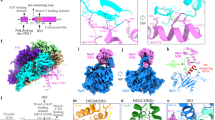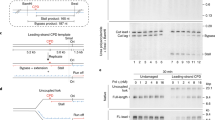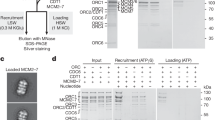Abstract
Chromosome replication is performed by a complex and intricate ensemble of proteins termed the replisome, where the DNA polymerases Polδ and Polε, DNA polymerase α-primase (Polα) and accessory proteins including AND-1, CLASPIN and TIMELESS–TIPIN (respectively known as Ctf4, Mrc1 and Tof1–Csm3 in Saccharomyces cerevisiae) are organized around the CDC45–MCM–GINS (CMG) replicative helicase1,2,3,4,5,6,7. Because a functional human replisome has not been reconstituted from purified proteins, how these factors contribute to human DNA replication and whether additional proteins are required for optimal DNA synthesis are poorly understood. Here we report the biochemical reconstitution of human replisomes that perform fast and efficient DNA replication using 11 purified human replication factors made from 43 polypeptides. Polε, but not Polδ, is crucial for optimal leading-strand synthesis. Unexpectedly, Polε-mediated leading-strand replication is highly dependent on the sliding-clamp processivity factor PCNA and the alternative clamp loader complex CTF18–RFC. We show how CLASPIN and TIMELESS–TIPIN contribute to replisome progression and demonstrate that, in contrast to the budding yeast replisome8, AND-1 directly augments leading-strand replication. Moreover, although AND-1 binds to Polα9,10, the interaction is dispensable for lagging-strand replication, indicating that Polα is functionally recruited via an AND-1-independent mechanism for priming in the human replisome. Collectively, our work reveals how the human replisome achieves fast and efficient leading-strand and lagging-strand DNA replication, and provides a powerful system for future studies of the human replisome and its interactions with other DNA metabolic processes.
This is a preview of subscription content, access via your institution
Access options
Access Nature and 54 other Nature Portfolio journals
Get Nature+, our best-value online-access subscription
$29.99 / 30 days
cancel any time
Subscribe to this journal
Receive 51 print issues and online access
$199.00 per year
only $3.90 per issue
Buy this article
- Purchase on SpringerLink
- Instant access to full article PDF
Prices may be subject to local taxes which are calculated during checkout





Similar content being viewed by others
Data availability
The data supporting the findings of this study are available within the paper and its Supplementary Information files.
References
Baretić, D. et al. Cryo-EM structure of the fork protection complex bound to CMG at a replication fork. Mol. Cell 78, 926–940.e13 (2020).
Jones, M. L., Baris, Y., Taylor, M. R. G. & Yeeles, J. T. P. Structure of a human replisome shows the organisation and interactions of a DNA replication machine. EMBO J. 40, e108819 (2021).
Goswami, P. et al. Structure of DNA-CMG-Pol epsilon elucidates the roles of the non-catalytic polymerase modules in the eukaryotic replisome. Nat. Commun. 9, 5061 (2018).
Yuan, Z. et al. Ctf4 organizes sister replisomes and Pol alpha into a replication factory. eLife 8, e47405 (2019).
Rzechorzek, N. J. et al. CryoEM structures of human CMG–ATPγS–DNA and CMG–AND-1 complexes. Nucleic Acids Res. 48, 6980–6995 (2020).
Kapadia, N. et al. Processive activity of replicative DNA polymerases in the replisome of live eukaryotic cells. Mol. Cell 80, 114–126.e8 (2020).
Lewis, J. S. et al. Tunability of DNA polymerase stability during eukaryotic DNA replication. Mol. Cell 77, 17–25.e5 (2020).
Yeeles, J. T. P., Janska, A., Early, A. & Diffley, J. F. X. How the eukaryotic replisome achieves rapid and efficient DNA replication. Mol. Cell 65, 105–116 (2017).
Kilkenny, M. L. et al. The human CTF4-orthologue AND-1 interacts with DNA polymerase alpha/primase via its unique C-terminal HMG box. Open Biol. 7, 170217 (2017).
Guan, C., Li, J., Sun, D., Liu, Y. & Liang, H. The structure and polymerase-recognition mechanism of the crucial adaptor protein AND-1 in the human replisome. J. Biol. Chem. 292, 9627–9636 (2017).
Petermann, E., Helleday, T. & Caldecott, K. W. Claspin promotes normal replication fork rates in human cells. Mol. Biol. Cell 19, 2373–2378 (2008).
Conti, C. et al. Replication fork velocities at adjacent replication origins are coordinately modified during DNA replication in human cells. Mol. Biol. Cell 18, 3059–3067 (2007).
Somyajit, K. et al. Redox-sensitive alteration of replisome architecture safeguards genome integrity. Science 358, 797–802 (2017).
Abe, T. et al. AND-1 fork protection function prevents fork resection and is essential for proliferation. Nat. Commun. 9, 3091 (2018).
Nick McElhinny, S. A., Gordenin, D. A., Stith, C. M., Burgers, P. M. & Kunkel, T. A. Division of labor at the eukaryotic replication fork. Mol. Cell 30, 137–144 (2008).
Pursell, Z. F., Isoz, I., Lundstrom, E. B., Johansson, E. & Kunkel, T. A. Yeast DNA polymerase epsilon participates in leading-strand DNA replication. Science 317, 127–130 (2007).
Aria, V. & Yeeles, J. T. P. Mechanism of bidirectional leading-strand synthesis establishment at eukaryotic DNA replication origins. Mol. Cell 73, 199–211.e10 (2019).
Grabarczyk, D. B., Silkenat, S. & Kisker, C. Structural basis for the recruitment of Ctf18-RFC to the replisome. Structure 26, 137–144.e3 (2018).
Stokes, K., Winczura, A., Song, B., Piccoli, G. & Grabarczyk, D. B. Ctf18-RFC and DNA Pol form a stable leading strand polymerase/clamp loader complex required for normal and perturbed DNA replication. Nucleic Acids Res. 48, 8128–8145 (2020).
Murakami, T. et al. Stable interaction between the human proliferating cell nuclear antigen loader complex Ctf18-replication factor C (RFC) and DNA polymerase ε is mediated by the cohesion-specific subunits, Ctf18, Dcc1, and Ctf8*. J. Biol. Chem. 285, 34608–34615 (2010).
Fujisawa, R., Ohashi, E., Hirota, K. & Tsurimoto, T. Human CTF18-RFC clamp-loader complexed with non-synthesising DNA polymerase ε efficiently loads the PCNA sliding clamp. Nucleic Acids Res. 45, 4550–4563 (2017).
Tunyasuvunakool, K. et al. Highly accurate protein structure prediction for the human proteome. Nature 596, 590–596 (2021).
Taylor, M. R. G. & Yeeles, J. T. P. The initial response of a eukaryotic replisome to DNA damage. Mol. Cell 70, 1067–1080.e12 (2018).
Georgescu, R. E. et al. Mechanism of asymmetric polymerase assembly at the eukaryotic replication fork. Nat. Struct. Mol. Biol. 21, 664–670 (2014).
Terret, M. E., Sherwood, R., Rahman, S., Qin, J. & Jallepalli, P. V. Cohesin acetylation speeds the replication fork. Nature 462, 231–234 (2009).
Crabbe, L. et al. Analysis of replication profiles reveals key role of RFC-Ctf18 in yeast replication stress response. Nat. Struct. Mol. Biol. 17, 1391–1397 (2010).
Hanna, J. S., Kroll, E. S., Lundblad, V. & Spencer, F. A. Saccharomyces cerevisiae CTF18 and CTF4 are required for sister chromatid cohesion. Mol. Cell. Biol. 21, 3144–3158 (2001).
Mayer, M. L., Gygi, S. P., Aebersold, R. & Hieter, P. Identification of RFC(Ctf18p, Ctf8p, Dcc1p): an alternative RFC complex required for sister chromatid cohesion in S. cerevisiae. Mol. Cell 7, 959–970 (2001).
Kawasumi, R. et al. Vertebrate CTF18 and DDX11 essential function in cohesion is bypassed by preventing WAPL-mediated cohesin release. Genes Dev. 35, 1368–1382 (2021).
Georgescu, R. E. et al. Reconstitution of a eukaryotic replisome reveals suppression mechanisms that define leading/lagging strand operation. eLife 4, e04988 (2015).
Henricksen, L. A., Umbricht, C. B. & Wold, M. S. Recombinant replication protein A: expression, complex formation, and functional characterization. J. Biol. Chem. 269, 11121–11132 (1994).
Sebesta, M. et al. Role of PCNA and TLS polymerases in D-loop extension during homologous recombination in humans. DNA Repair 12, 691–698 (2013).
Xing, X. et al. A recurrent cancer-associated substitution in DNA polymerase ε produces a hyperactive enzyme. Nat. Commun. 10, 374 (2019).
Acknowledgements
We thank J. Shi for operation of the LMB baculovirus facility, L. Passmore for protein expression vectors, M. Jones for advice on glycerol gradients, and L. Krejci and M. Wold for the RPA expression plasmid. This work was supported by the MRC, as part of UK Research and Innovation (MRC grant MC_UP_1201/12 to J.T.P.Y.), the Wellcome Trust (reference 110014/Z/15/Z) for a Sir Henry Wellcome Postdoctoral Fellowship to M.R.G.T and an LMB Cambridge Trust International Scholarship to Y.B.
Author information
Authors and Affiliations
Contributions
Y.B. performed all experiments, generated the expression vectors, prepared DNA templates and purified proteins, wrote the methods, and reviewed and edited the manuscript. M.R.G.T. conceptualized the study, acquired funding, performed preliminary DNA replication assays, generated the expression vectors, prepared DNA templates and purified proteins, and reviewed the manuscript. V.A. identified the CMG–Polα interaction. J.T.P.Y. conceptualized and supervised the study, acquired funding, prepared the DNA template and performed protein purification, wrote the original draft of the manuscript, and reviewed and edited the manuscript.
Corresponding author
Ethics declarations
Competing interests
The authors declare no competing interests.
Peer review
Peer review information
Nature thanks David Gilbert, Bruce Stillman and the other, anonymous, reviewer(s) for their contribution to the peer review of this work. Peer reviewer reports are available.
Additional information
Publisher’s note Springer Nature remains neutral with regard to jurisdictional claims in published maps and institutional affiliations.
Extended data figures and tables
Extended Data Fig. 1 Purified human DNA replication proteins.
Coomassie stained SDS-PAGE of human DNA replication proteins. Individual lanes from the gel in Fig. 1a are shown with each subunit labelled.
Extended Data Fig. 2 Leading-strand synthesis.
a, Standard replication reaction on the 9.7 kbp template performed with the indicated proteins and analysed by native and denaturing agarose gel electrophoresis as indicated. In the absence of RFC and PCNA the predominant replication products (intermediates) migrate above the position of full length in the native gel. As indicated, in the native gel template labelling products and complete full-length replication products migrate in the same position. b, Denaturing agarose gel analysis of a pulse chase experiment on the 9.7 kbp template with the indicated proteins. Unless otherwise stated, in this and all pulse chase experiments, the chase was added at 50 s. c, Denaturing agarose gel analysis of a replication reaction on the 9.7 kbp template with the indicated proteins. d, Denaturing agarose gel analysis of a pulse chase experiment on the 9.7 kbp template with the indicated proteins.
Extended Data Fig. 3 CTF18-RFC is required for optimal leading-strand synthesis.
a, Denaturing agarose gel analysis of a replication reaction on the 9.7 kbp template with the indicated proteins. b, Denaturing agarose gel analysis of a pulse chase experiment on the 9.7 kbp template with the indicated proteins. c, Silver-stained SDS-PAGE analysis of glycerol gradients performed with the indicated proteins. For clarity, only CMG, CTF18-RFC and Pol ε subunits are annotated. d, Coomassie stained SDS-PAGE of CTF18-RFC and Pol ε interaction mutants. e, Silver-stained SDS-PAGE analysis of a pull-down experiment with the indicated proteins showing that mutation of CTF18 and POLE1 disrupt the interaction between the two proteins. f, Denaturing agarose gel analysis of a replication reaction performed for 3 min on the 9.7 kbp template with the indicated proteins.
Extended Data Fig. 4 CTF18-RFC accelerates established replication forks.
a, Lane profiles of the 165 s timepoints in Fig. 3e where CTF18-RFC was absent or added in the chase (lanes 2 and 8 respectively). b, Denaturing agarose gel analysis of a pulse chase experiment on the 15.8 kbp template with the indicated proteins. Where indicated CTF18-RFC or CTF18-RFCRAA were added with the chase. c, Lane profiles of the 240 s timepoints in (b). For lane profiles (a, c), product intensities were normalised by dividing each value by the relative intensity of the total signal in a given lane.
Extended Data Fig. 5 PCNA loading by CTF18-RFC is required for optimal leading-strand synthesis.
a, Coomassie stained SDS-PAGE of CTF18-1-8 module complexes. b, Silver-stained SDS-PAGE analysis of a pull-down experiment with the indicated proteins showing that the CTF18-1-8 module interacts specifically with Pol ε. c, Coomassie stained SDS-PAGE of WT and CTF18K380E complexes. d, Silver-stained SDS-PAGE analysis of a pull-down experiment with the indicated proteins showing that CTF18K380E-RFC retains the capacity to interact with Pol ε. e, f, Primer extension reactions on M13mp18 single-strand DNA with Pol δ and Pol ε showing that CTF18K380E-RFC has a severe defect in supporting PCNA-dependent DNA synthesis by both polymerases. g, (left) Denaturing agarose gel analysis of a pulse-chase experiment on the 15.8 kbp template with the indicated proteins. The chase was added at 1 min 45 s. Where indicated CTF18-RFC or CTF18K380E-RFC were added with the chase. (right) Lane profiles for the 5 min timepoint. Data were normalised by dividing each intensity value by the relative total signal at the 2 min timepoint.
Extended Data Fig. 6 TIM-TIPIN, CLASPIN and AND-1 enhance leading-strand replication.
a, Denaturing agarose gel analysis of a time course experiment on the 15.8 kbp template with the indicated proteins at two concentrations of potassium glutamate (K-Glu). b, c, Lane profiles of the data in Fig. 4a, b respectively. d, Denaturing agarose gel analysis (top) and lane profiles (bottom) of a 3 min 45 s replication reaction on the 15.8 kbp template with the indicated proteins. e, Lane profiles of the data in Fig. 4c. TT, TIM-TIPIN. f, Denaturing agarose gel analysis (top) and lane profile (bottom) of a 3 min 45 s replication reaction on the 15.8 kbp template with the indicated proteins. TT, TIM-TIPIN. g, Denaturing agarose gel analysis of a 3.5 min replication reaction on the 15.8 kbp template with the indicated proteins. In d, f, g, the potassium glutamate concentration was 250 mM. For lane profiles (b–f), product intensities were normalised by dividing each value by the relative intensity of the total signal in a given lane.
Extended Data Fig. 7 CLASPIN and AND-1 truncations.
a, Cartoon representation of the core human replisome (PDB:7PFO)2 showing the region of CLASPIN (E284–K319) that interacts with the TIM α-solenoid. b, Coomassie stained SDS-PAGE of CLASPIN truncation mutants. c, d Lane profiles of the data in Fig. 4e. e, Coomassie stained SDS-PAGE of AND-1 truncation mutants. f, Lane profiles of the data in Fig. 4g. For lane profiles (c, d, f), product intensities were normalised by dividing each value by the relative intensity of the total signal in a given lane.
Extended Data Fig. 8 Reconstitution of lagging-strand replication.
a, Denaturing agarose gel analysis of a 20 min replication on the 9.7 kbp template with the indicated proteins. b, Lane profiles from lanes 3 and 4 in (a). c, Schematic showing the possible replication products (–/+ Pol δ) if lagging strands are extended by Pol δ and are constituents of both replication intermediates and full-length products. d, e, Two-dimensional agarose gel analysis of 20 min replication reactions performed with the indicated proteins on the 9.7 kbp template in the absence (d) and presence (e) of Pol δ. In all reactions, the concentration of potassium glutamate was 250 mM.
Extended Data Fig. 9 Lagging-strand replication occurs at all replication forks.
a, Schematic of a replication reaction on the cyclobutane pyrimidine dimer (CPD) template. b, Native and denaturing gel analysis of a time course experiment on undamaged and CPD templates with the indicated proteins. c, Native and denaturing gel analysis of a 60 min reaction on the CPD template with different concentrations of Pol α as indicated. d, e, Two-dimensional agarose gel analysis of 30 min replication reactions performed with the indicated proteins on the CPD template in the absence (d) and presence (e) of Pol α. In all reactions, the concentration of potassium glutamate was 250 mM.
Extended Data Fig. 10 Role of AND-1 in lagging-strand replication.
a, Lane profiles from Fig. 5d, lanes 5 and 6. b, Lane profiles from the experiment in Fig. 5e, lanes 2, 3, 5, 7, 8 and 10. c, Denaturing agarose gel analysis of a 30 min reaction on the 9.7 kbp template with the indicated proteins. d, Silver-stained SDS-PAGE analysis of glycerol gradients performed with the indicated proteins demonstrating complex formation between Pol α and CMG in the absence of replication fork DNA.
Supplementary information
Supplementary
This file contains Supplementary Tables 1–2 and Supplementary Fig. 1 (the uncropped gels).
Rights and permissions
About this article
Cite this article
Baris, Y., Taylor, M.R.G., Aria, V. et al. Fast and efficient DNA replication with purified human proteins. Nature 606, 204–210 (2022). https://doi.org/10.1038/s41586-022-04759-1
Received:
Accepted:
Published:
Issue Date:
DOI: https://doi.org/10.1038/s41586-022-04759-1
This article is cited by
-
Structures of the human leading strand Polε–PCNA holoenzyme
Nature Communications (2024)
-
Control of DNA replication in vitro using a reversible replication barrier
Nature Protocols (2024)
-
Quantity and quality of minichromosome maintenance protein complexes couple replication licensing to genome integrity
Communications Biology (2024)
-
Structural basis for processive daughter-strand synthesis and proofreading by the human leading-strand DNA polymerase Pol ε
Nature Structural & Molecular Biology (2024)
-
Stabilization of expandable DNA repeats by the replication factor Mcm10 promotes cell viability
Nature Communications (2024)



